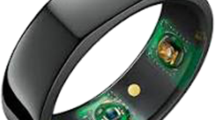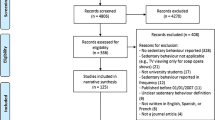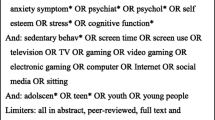Abstract
Sedentary behaviors are now prevalent as most modern jobs are done while seated. However, such sedentary behaviors have been found to increase the risk of several ailments including diabetes, cardiovascular disease, and all-cause mortality. Current interventions are mostly reactive and are triggered after the user has already been sedentary. Behavior change theory suggests that preventive sedentary interventions, which are triggered before a person becomes sedentary, are more likely to succeed. In this paper, we characterize user patterns of sedentary behaviors by analyzing smartphone-sensor data in a real-world dataset. Our work reveals location types (where), times of day/week (when), and smartphone contexts in which sedentary behaviors are most likely. Leveraging our findings, we then propose a set of context-aware probabilistic models that can predict sedentary behaviors in advance by analyzing smartphone sensor data. Our Context-Aware Predictive (CAP) models leverage smartphone-sensed contextual variables and the user’s history of sedentary behaviors to predict their future sedentary behaviors. We rigorously analyze the performance of our models and discuss the implications of our work.




























Similar content being viewed by others
Notes
On the website of StudentLife project and in [11], the authors state that 48 students completed the study. The StudentLife dataset, however, contains 49 students’ data.
Hereafter, without explicit mention, superscripts used in notations are time indexes, not powers.
On the website of StudentLife project, the authors mentioned a “user_info.csv” file which might contain subjects’ demographic information. However, in the data publicly provided, such a file does not exist.
Dell PowerEdge T20 Owner’s Manual, https://dl.dell.com/topicspdf/poweredge-t20_owners-manual_en-us.pdf
Intel® Xeon® Processor E3-1225 v3 https://ark.intel.com/content/www/us/en/ark/products/75461/intel-xeon-processor-e3-1225-v3-8m-cache-3-20-ghz.html
“Don’t kill apps, make them work!” website, https://dontkillmyapp.com/
References
Proctor RW, Van Zandt T (2008) Human factors in simple and complex systems. 2nd edn. Taylor & Francis. http://books.google.com/books?id=LfqDZ1VEmyoC
Centers for Disease Control and Prevention. Prevalence of Sedentary Leisure-time Behavior Among Adults in the United States (2010). https://www.cdc.gov/nchs/data/hestat/sedentary/sedentary.htm
Whitt-Glover MC, Taylor WC, Floyd MF, Yore MM, Yancey AK, Matthews CE (2009) Disparities in physical activity and sedentary behaviors among US children and adolescents: Prevalence, correlates, and intervention implications. J Public Health Pol 30(S1):S309. https://doi.org/10.1057/jphp.2008.46. http://www.palgrave-journals.com/doifinder/10.1057/jphp.2008.46
Wilmot EG, Edwardson CL, Achana FA, Davies MJ, Gorely T, Gray LJ, Khunti K, Yates T, Biddle SJH (2012) Sedentary time in adults and the association with diabetes, cardiovascular disease and death: systematic review and meta-analysis. Diabetologia 55(11):2895. https://doi.org/10.1007/s00125-012-2677-z
Proper KI, Singh AS, van Mechelen W, Chinapaw MJM (2011) Sedentary behaviors and health outcomes among adults: a systematic review of prospective studies. Amer J Prevent Med 40(2):174. https://doi.org/10.1016/j.amepre.2010.10.015. http://www.sciencedirect.com/science/article/pii/S0749379710006082
Lees SJ, Booth FW (2004) Sedentary death syndrome. Canadian J Appl Physiol 29(4):447. https://doi.org/10.1139/h04-029
Pate RR, O’Neill JR, Lobelo F (2008) The evolving definition of “sedentary”. Exer Sport Sci Rev 36(4):173. https://doi.org/10.1097/JES.0b013e3181877d1a. http://www.ncbi.nlm.nih.gov/pubmed/18815485
Tremblay M (2012) Letter to the Editor: Standardized use of the terms “sedentary” and “sedentary behaviours”. Appl Physiol Nutrit Metabol 37(3):540. https://doi.org/10.1139/h2012-024
Consolvo S, Libby R, Smith I, Landay JA, McDonald DW, Toscos T, Chen MY, Froehlich J, Harrison B, Klasnja P, LaMarca A, LeGrand L (2008) Activity sensing in the wild: a field trial of ubifit garden. In: Proceeding of the twenty-sixth annual CHI conference on Human factors in computing systems - CHI ’08. https://doi.org/10.1145/1357054.1357335. http://dl.acm.org/citation.cfm?id=1357054.1357335. ACM Press, New York, p 1797
Lane N, Mohammod M, Lin M, Yang X, Lu H, Ali S, Doryab A, Berke E, Choudhury T, Campbell A (2011) BeWell: a smartphone application to monitor, model and promote wellbeing. In: Proceedings of the 5th international ICST conference on pervasive computing technologies for healthcare. https://doi.org/10.4108/icst.pervasivehealth.2011.246161. http://eudl.eu/doi/10.4108/icst.pervasivehealth.2011.246161
Wang R, Chen F, Chen Z, Li T, Harari G, Tignor S, Zhou X, Ben-Zeev D, Campbell AT (2014) StudentLife: assessing mental health, academic performance and behavioral trends of college students using smartphones. In: Proceedings of the 2014 ACM international joint conference on pervasive and ubiquitous computing - UbiComp ’14 Adjunct. https://doi.org/10.1145/2632048.2632054. http://dl.acm.org/citation.cfm?id=2632048.2632054. ACM Press, New York, pp 3–14
He Q, Agu E (2014) On11: An activity recommendation application to mitigate sedentary lifestyle. In: Proceedings of the 2014 workshop on physical analytics - WPA ’14. https://doi.org/10.1145/2611264.2611268. http://dl.acm.org/citation.cfm?doid=2611264.2611268. ACM Press, New York, pp 3–8
Apple Inc. Apple Watch (2015). http://www.apple.com/watch/
Fitbit Inc. Fitbit (2013). http://www.fitbit.com/
Ajzen I (1991) The theory of planned behavior. Organ Behav Human Decis Process 50(2):179. https://doi.org/10.1016/0749-5978(91)90020-T. http://www.sciencedirect.com/science/article/pii/074959789190020T
Abowd GD, Dey AK, Brown PJ, Davies N, Smith M, Steggles P (1999) Towards a better understanding of context and context-awareness. 304–307. https://doi.org/10.1007/3-540-48157-5_29. http://link.springer.com/10.1007/3-540-48157-5_29
Shaw RJ, Steinberg DM, Zullig LL, Bosworth HB, Johnson CM, Davis LL (2014) mHealth interventions for weight loss: a guide for achieving treatment fidelity. J Ameri Med Inf Assoc : JAMIA 21(6):959. https://doi.org/10.1136/amiajnl-2013-002610. http://jamia.oxfordjournals.org/content/21/6/959.abstract
Patel AV, Bernstein L, Deka A, Feigelson HS, Campbell PT, Gapstur SM, Colditz GA, Thun MJ (2010) Leisure time spent sitting in relation to total mortality in a prospective cohort of US adults. Amer J Epidemiol 172(4):419. https://doi.org/10.1093/aje/kwq155. http://aje.oxfordjournals.org/content/172/4/419http://aje.oxfordjournals.org/cgi/doi/10.1093/aje/kwq155
Thorp AA, Owen N, Neuhaus M, Dunstan DW (2011) Sedentary behaviors and subsequent health outcomes in adults a systematic review of longitudinal studies, 1996-2011. Amer J Prevent Med 41(2):207. https://doi.org/10.1016/j.amepre.2011.05.004. http://www.sciencedirect.com/science/article/pii/S0749379711003126
Chen G, Kotz D (2000) A survey of context-aware mobile computing research. Dartmouth Comput Sci Tech Report 3755:1. https://dl.acm.org/doi/10.5555/867843https://dl.acm.org/doi/10.5555/867843
Schilit BN, Adams N, Want R (1994) Context-aware computing applications. Context-Aware Comput Appl. https://doi.org/10.1109/MCSA.1994.512740. http://ieeexplore.ieee.org/xpls/abs_all.jsp?arnumber=4624429
Indulska J, Sutton P (2003) Location management in pervasive systems. Conf Res Pract Inf Technol Ser 34:143. http://portal.acm.org/citation.cfm?id=827987.828003
Baldauf M, Dustdar S, Rosenberg F (2007) A survey on context-aware systems. Int J Ad Hoc Ubiquit Comput 2(4):263. http://inderscience.metapress.com/content/1184787H28163T15
LiKamWa R, Liu Y, Lane ND, Zhong L (2013) MoodScope: building a mood sensor from smartphone usage patterns. In: Proceeding of the 11th annual international conference on Mobile systems, applications, and services - MobiSys ’13. https://doi.org/10.1145/2462456.2464449. http://dl.acm.org/citation.cfm?doid=2462456.2464449. ACM Press, New York, p 389
Pielot M, Dingler T, Pedro JS, Oliver N (2015) When attention is not scarce - detecting boredom from mobile phone usage. In: Proceedings of the 2015 ACM international joint conference on pervasive and ubiquitous computing - UbiComp ’15. https://doi.org/10.1145/2750858.2804252. http://dl.acm.org/citation.cfm?doid=2750858.2804252. ACM Press, New York, pp 825–836
Anderson M (2015) U.S. Technology Device Ownership 2015. http://www.pewinternet.org/2015/10/29/technology-device-ownership-2015/
Bettini C, Brdiczka O, Henricksen K, Indulska J, Nicklas D, Ranganathan A, Riboni D (2010) A survey of context modelling and reasoning techniques. Perv Mobile Comput 6(2):161. https://doi.org/10.1016/j.pmcj.2009.06.002. http://linkinghub.elsevier.com/retrieve/pii/S1574119209000510
Klasnja P, Consolvo S, McDonald DW, Landay JA, Pratt W (2009) AMIA... Annual Symposium proceedings. AMIA Symposium 2009, 338. http://www.ncbi.nlm.nih.gov/pubmed/20351876http://www.pubmedcentral.nih.gov/articlerender.fcgi?artid=PMC2815473
Lin Y (2013) Motivate : a context-aware mobile application for physical activity promotion. Ph.D. thesis, Technische Universiteit Eindhoven. http://repository.tue.nl/750185
He Q (2014) A Context-aware smartphone application to mitigate sedentary lifestyle. Ph.D. thesis, Worcester Polytechnic Institute. https://www.wpi.edu/Pubs/ETD/Available/etd-092914-135436/
Klein M, Mogles N, van Wissen A (2013) An intelligent coaching system for therapy adherence. IEEE Perv Comput 12 (3):22. https://doi.org/10.1109/MPRV.2013.41. http://ieeexplore.ieee.org/lpdocs/epic03/wrapper.htm?arnumber=6514027
Pentland A, Liu A (1999) Modeling and prediction of human behavior. Neural Comput 11(1):229. https://doi.org/10.1162/089976699300016890. http://www.mitpressjournals.org/doi/abs/10.1162/089976699300016890
Viard K, Fanti MP, Faraut G, Lesage JJ (2020) Human activity discovery and recognition using probabilistic finite-state automata. IEEE Trans Automa Sci Eng 17 https://doi.org/10.1109/TASE.2020.2989226
Baum LE, Petrie T (1966) Statistical inference for probabilistic functions of finite state markov chains. Ann Math Stat 37(6):1554. https://doi.org/10.1214/aoms/1177699147. http://projecteuclid.org/euclid.aoms/1177699147
Lafferty JD, McCallum A, Pereira FCN (2001) Conditional random fields: probabilistic models for segmenting and labeling sequence data. In: Proceedings of the eighteenth international conference on machine learning, ICML ’01. http://dl.acm.org/citation.cfm?id=645530.655813. Morgan Kaufmann Publishers Inc., San Francisco, pp 282–289
Friedman N, Geiger D, Goldszmidt M (1997) Bayesian network classifiers. Mach Learn 29:131. https://doi.org/10.1023/A:1007465528199. https://doi.org/10.1023/A:1007465528199ation/doi/10.1023/A:1007465528199
Atallah L, Yang GZ (2009) The use of pervasive sensing for behaviour profiling – a survey. Perv Mobile Comput 5(5):447. https://doi.org/10.1016/j.pmcj.2009.06.009. http://linkinghub.elsevier.com/retrieve/pii/S1574119209000583
He Q, Agu EO (2017) A rhythm analysis-based model to predict sedentary behaviors. IEEE 383–391. https://doi.org/10.1109/CHASE.2017.122. http://ieeexplore.ieee.org/document/8010677/
He Q, Agu E (2016) Towards sedentary lifestyle prevention: an autoregressive model for predicting sedentary behaviors. In: IEEE 10Th international symposium on medical information and communication technology (ISMICT ’16) (Worcester, MA, USA)
He Q, Agu E (2016) A frequency domain algorithm to identify recurrent sedentary behaviors from activity time-series data. In: 2016 IEEE-EMBS international conference on biomedical and health informatics (BHI). https://doi.org/10.1109/BHI.2016.7455831, pp 45–48
Kańtoch E (2018) Recognition of sedentary behavior by machine learning analysis of wearable sensors during activities of daily living for telemedical assessment of cardiovascular risk. Sensors 18:8–12. https://doi.org/10.3390/s18103219
Bhattacharjee P, Kar SP, Rout NK (2020) Sleep and sedentary behavior analysis from physiological signals using machine learning. IEEE. https://doi.org/10.1109/ICIMIA48430.2020.9074883
Cook DJ, Krishnan NC (2015) Activity learning, discovering, recognizing, and predicting human behavior from sensor data. Wiley, Hoboken. https://doi.org/10.1002/9781119010258. http://doi.wiley.com/10.1002/9781119010258
Fahim M, Baker T, Khattak A, Shah B, Aleem S, Chow F (2018) Context mining of sedentary behaviour for promoting self-awareness using a smartphone. Sensors 18:8–12. https://doi.org/10.3390/s18030874
Nweke HF, Teh YW, Al-garadi MA, Alo UR (2018) Deep learning algorithms for human activity recognition using mobile and wearable sensor networks: state of the art and research challenges. Expert Syst Appl 105:196–206. https://doi.org/10.1016/j.eswa.2018.03.056
Kong Y, Fu Y (2018) Human action recognition and prediction: a survey. arXiv:1806.11230
Li X, Ge Y, Li W, Ma C (2018) A quantitative system of sedentary condition based on wireless body area network. https://doi.org/10.1007/978-3-319-97795-9_11
Do TMT, Gatica-Perez D (2012) Contextual conditional models for smartphone-based human mobility prediction. In: Proceedings of the 2012 ACM conference on ubiquitous computing - UbiComp ’12. https://doi.org/10.1145/2370216.2370242. http://dl.acm.org/citation.cfm?doid=2370216.2370242. ACM Press, New York, p 163
Mansoor H, Gerych W, Alajaji A, Buquicchio L, Chandrasekaran K, Agu E, Rundensteiner EA (2021) Visual analytics of smartphone-sensed human behavior and health. IEEE Comput Graph Appl 41:98–101. https://doi.org/10.1109/MCG.2021.3062474
Thorp AA, Healy GN, Winkler E, Clark BK, Gardiner PA, Owen N, Dunstan DW (2012) Prolonged sedentary time and physical activity in workplace and non-work contexts: a cross-sectional study of office, customer service and call centre employees. Int J Behav Nutrit Phys Activ 9(1):128. https://doi.org/10.1186/1479-5868-9-128. http://www.ijbnpa.org/content/9/1/128
Matthews CE, Chen KY, Freedson PS, Buchowski MS, Beech BM, Pate RR, Troiano RP (2008) Amount of time spent in sedentary behaviors in the United States, 2003-2004. Amer J Epidemiol 167(7):875. https://doi.org/10.1093/aje/kwm390. http://aje.oxfordjournals.org/content/167/7/875.short
Cornell university ergonomics. sitting and standing at work (2016). http://ergo.human.cornell.edu/CUESitStand.html
Xu Y, Lin M, Lu H, Cardone G, Lane N, Chen Z, Campbell A, Choudhury T (2013) Preference, context and communities: a multi-faceted approach to predicting smartphone app usage patterns. In: Proceedings of the 17th annual international symposium on international symposium on wearable computers - ISWC ’13. https://doi.org/10.1145/2493988.2494333. http://dl.acm.org/citation.cfm?doid=2493988.2494333. ACM Press, New York, p 69
Barkhuus L, Dourish P (2004) Everyday encounters with context-aware computing in a campus environment. In: Davies N, Mynatt E, Siio I (eds) UbiComp 2004: Ubiquitous Computing SE - 14, Lecture Notes in Computer Science. https://doi.org/10.1007/978-3-540-30119-6_14, vol 3205. Springer Berlin Heidelberg, pp 232–249
Pearson K (1895) Note on regression and inheritance in the case of two parents. Proc R Soc Lond 58:240
Dartmouth college. Hopkins center for the arts (2013). https://hop.dartmouth.edu/
Eagle N, Pentland A (2009) Eigenbehaviors: identifying structure in routine. Behav Ecol Sociobiol 63(7):1057. https://doi.org/10.1007/s00265-009-0739-0
Rish I (2001) An empirical study of the naive Bayes classifier. IJCAI 2001 Workshop on Empirical Methods in Artif Intell 3(22):41–46. https://doi.org/10.1039/b104835j
Sutton C, McCallum A (2010) An introduction to conditional random fields. arXiv:1011.4088
Chung S (2015) Breaking down prediction errors in machine learning. Tech. rep., Alpine Data. http://alpinedata.com/wp-content/uploads/2015/12/ML-Whitepaper_12.29.pdf
Agre PE (1988) The dynamic structure of everyday life. Tech. rep., Cambridge, MA USA
Turner W (1545) Winchester: Gardiner
Chemla K (2012) The mathematics of Egypt, Mesopotamia, China, India, and Islam. A sourcebook. Historia Math 39(3):324. https://doi.org/10.1016/j.hm.2012.04.003. https://books.google.com/books?id=3ullzl036UEChttp://linkinghub.elsevier.com/retrieve/pii/S0315086012000316
Mount MK, Barrick MR (1995) The Big Five personality dimensions: implications for research and practice in human resources management. Res Personnel Human Resour Manag 13(3):153
Diener E, Wirtz D, Tov W, Kim-Prieto C, Choi DW, Oishi S, Biswas-Diener R (2010) New well-being measures: short scales to assess flourishing and positive and negative feelings. Soc Indic Res 97(2):143. https://doi.org/10.1007/s11205-009-9493-y. http://link.springer.com/10.1007/s11205-009-9493-y
Russell DW (1996) UCLA loneliness scale (Version 3): reliability, validity, and factor structure. J Person Assess 66 (1):20. https://doi.org/10.1207/s15327752jpa6601_2. http://www.tandfonline.com/doi/abs/10.1207/s15327752jpa6601_2
Watson D, Clark LA, Tellegen A (1988) Development and validation of brief measures of positive and negative affect: The PANAS scales. J Person Social Psychol 54(6):1063. https://doi.org/10.1037/0022-3514.54.6.1063. http://doi.apa.org/getdoi.cfm?doi=10.1037/0022-3514.54.6.1063
Cohen S, Kamarck T, Mermelstein R (1983) A global measure of perceived stress. J Health Soc Behav 24(4):385. https://doi.org/10.2307/2136404. http://www.jstor.org/stable/2136404
Kroenke K, Spitzer RL, Williams JBW (2001) The PHQ-9. J Gen Internal Med 16(9):606. https://doi.org/10.1046/j.1525-1497.2001.016009606.x. http://link.springer.com/10.1046/j.1525-1497.2001.016009606.x
Buysse DJ, Reynolds CF, Monk TH, Berman SR, Kupfer DJ (1989) The Pittsburgh sleep quality index: a new instrument for psychiatric practice and research. Psychiat Res 28(2):193. https://doi.org/10.1016/0165-1781(89)90047-4. http://linkinghub.elsevier.com/retrieve/pii/0165178189900474
Selim AJ, Rogers W, Fleishman JA, Qian SX, Fincke BG, Rothendler JA, Kazis LE (2009) Updated U.S. population standard for the Veterans RAND 12-item health survey (VR-12). Qual Life Res 18(1):43. https://doi.org/10.1007/s11136-008-9418-2. http://link.springer.com/10.1007/s11136-008-9418-2
Dempster AP, Laird NM, Rubin DB (1977) Maximum likelihood from incomplete data via the EM algorithm. J Royal Stat Soc Ser B (Methodological) 39(1):1. http://www.jstor.org/stable/2984875
Macqueen J et al (1967) Some methods for classification and analysis of multivariate observations
Advances and open problems in federated learning (2019). arXiv:1912.04977
He Q, Agu E, Strong D, Tulu B (2014) RecFit: a context-aware system for recommending physical activities. In: Proceedings of the 1st workshop on mobile medical applications - MMA ’14. https://doi.org/10.1145/2676431.2676439. http://dl.acm.org/citation.cfm?doid=2676431.2676439. ACM Press, New York, pp 34–39
Author information
Authors and Affiliations
Corresponding author
Ethics declarations
Conflict of Interest
The authors declare no competing interests.
Additional information
Publisher’s Note
Springer Nature remains neutral with regard to jurisdictional claims in published maps and institutional affiliations.
Rights and permissions
About this article
Cite this article
He, Q., Agu, E.O. Context-Aware Probabilistic Models for Predicting Future Sedentary Behaviors of Smartphone Users. J Healthc Inform Res 6, 112–152 (2022). https://doi.org/10.1007/s41666-021-00107-6
Received:
Revised:
Accepted:
Published:
Issue Date:
DOI: https://doi.org/10.1007/s41666-021-00107-6




